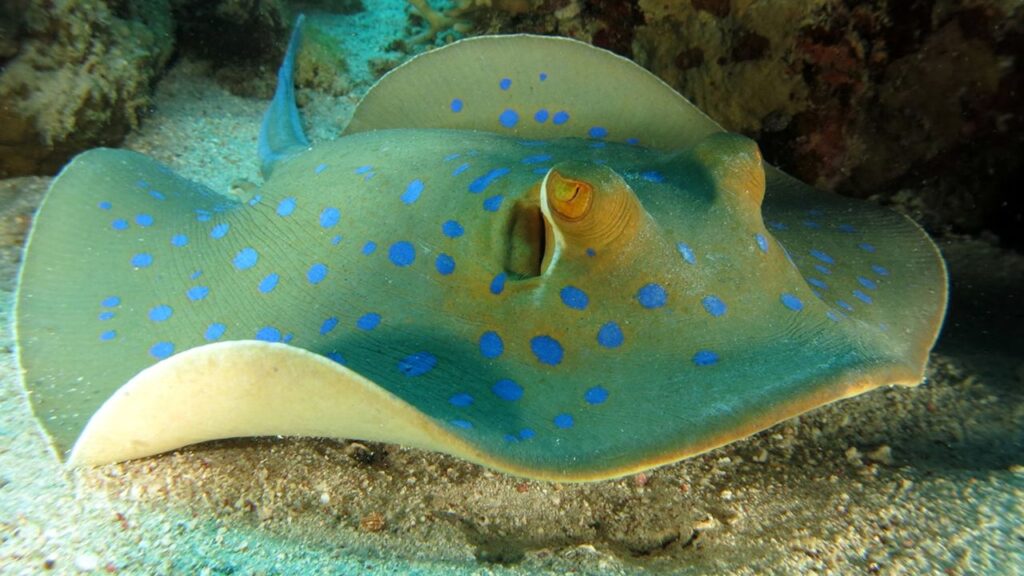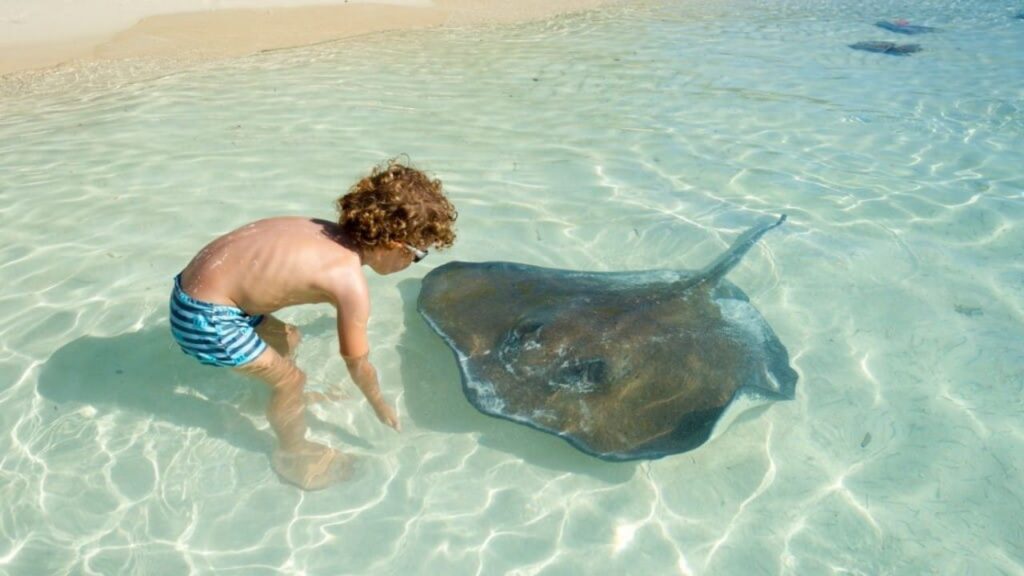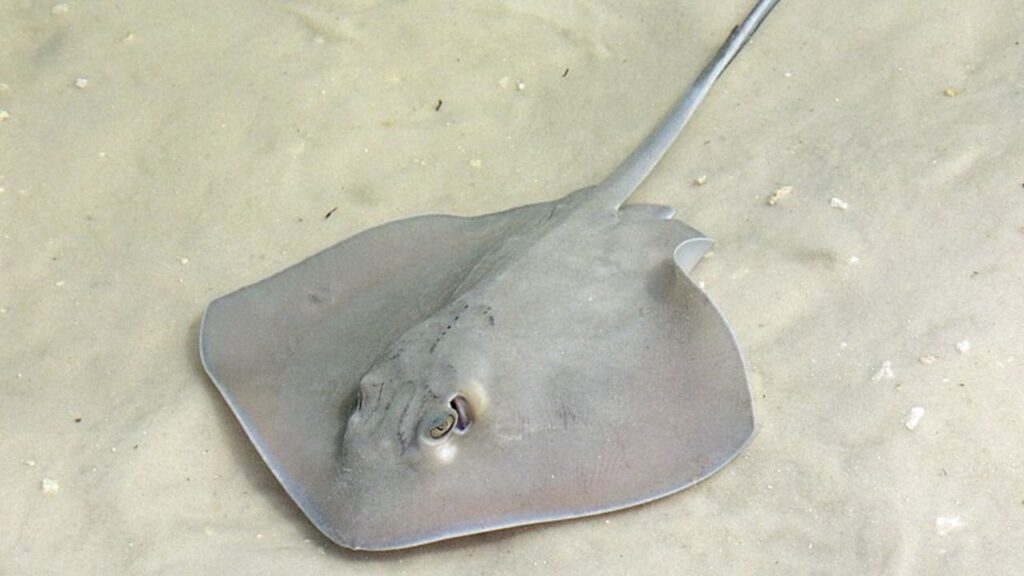Do Stingrays Attack Humans? Stingrays generally do not attack humans and are considered docile creatures, but they can sting defensively if stepped on or threatened.
Stingrays are often surrounded by a cloud of misconceptions, particularly regarding their interactions with humans.
Most people imagine these creatures as aggressive attackers lurking in the ocean, waiting to sting anyone who comes close.
However, the reality is quite different. Stingrays are generally peaceful and prefer to avoid humans. They only sting in self-defense when they feel threatened or accidentally stepped on.
In this comprehensive guide, we will delve into the nature of stingrays, their behavior around humans, the potential risks of stingray stings, and how to minimize those risks through awareness and safety measures.
Contents
What Are Stingrays?
Description of Stingrays
Stingrays belong to the family of sea rays and are related to sharks, as both are members of the Elasmobranch group. They have flat, diamond-shaped bodies with long, whip-like tails that contain barbed stingers.
These stingers are equipped with venom glands that release toxins when the stingray feels threatened. Stingrays range in size from small, palm-sized varieties to larger species that can span up to 7 feet in width and weigh several hundred pounds.
Despite their somewhat intimidating appearance, stingrays are typically gentle creatures that prefer solitude and avoid confrontation.
Stingray Habitats
Stingrays are widely distributed across the world’s oceans and are commonly found in tropical and subtropical waters. They favor shallow coastal regions, where they can easily find food such as mollusks, crustaceans, and small fish.
These creatures are often seen in sandy or muddy bottom environments, where they bury themselves to hide from predators and ambush prey.
While most stingrays are marine, there are also freshwater species that inhabit rivers and lakes in South America and Southeast Asia.
Their ability to adapt to different environments makes them fascinating and diverse members of marine life. [Do Stingrays Attack Humans?]

Do Stingrays Attack Humans?
Nature of Stingrays
Contrary to popular belief, stingrays do not attack humans intentionally. They are shy, docile creatures that spend most of their time lying on the ocean floor or swimming close to the seabed.
When approached by a human, their usual response is to swim away quickly rather than engage. Stingrays are more likely to flee than to fight, as they perceive humans as potential threats.
Their venomous stinger is primarily a defense mechanism against predators like sharks, not a tool for attacking humans.
Defensive Reactions
Stingrays have a unique way of defending themselves. When they feel threatened, they may lash out with their tail, embedding their barbed stinger into the perceived threat. This reaction is purely defensive and not an aggressive act.
Most stingray injuries to humans occur when someone accidentally steps on a stingray that is buried in the sand. [Do Stingrays Attack Humans?]
Feeling trapped and unable to swim away, the stingray reacts instinctively to defend itself. It is important to note that this is not an attack in the traditional sense but a reflexive response to avoid harm.
Frequency of Attacks
The idea that stingrays frequently attack humans is a myth. Stingray stings are rare, especially when compared to other marine-related injuries such as jellyfish stings or shark bites.
Most encounters between humans and stingrays are peaceful, particularly in areas where these creatures are accustomed to human presence.
For example, places like Stingray City in the Cayman Islands are famous for their large populations of friendly stingrays that interact regularly with tourists, further debunking the myth of the “attacking” stingray.
Are Stingray Stings Dangerous?
Types of Injuries
Stingray stings can result in various injuries, ranging from minor to severe. The injuries usually involve puncture wounds from the stinger, which can sometimes lodge in the skin.
The venom can cause intense, immediate pain, along with swelling, redness, and muscle cramps. [Do Stingrays Attack Humans?]
In more severe cases, the stinger may cause deep lacerations that require surgical intervention. The pain is often described as excruciating, with the affected area becoming swollen and tender.
Potential Complications
While stingray stings are rarely fatal, complications can arise if the wound is not treated properly. These complications may include bacterial infections, which can lead to cellulitis or abscesses.
The venom can also cause tissue necrosis, where the affected tissue begins to die. Some people may have allergic reactions to the venom, resulting in more severe symptoms like difficulty breathing or anaphylaxis.
It is essential to seek medical attention after a sting to prevent these potential complications. [Do Stingrays Attack Humans?]

Why Do Stingrays Sting?
Defensive Mechanism
Stingrays use their stingers as a last resort when they cannot escape a perceived threat. They prefer to hide or flee rather than fight.
However, if they are cornered or stepped on, they will lash out with their tail. This behavior is instinctual and not a calculated decision to attack.
Misinterpretation by Humans
Humans often misinterpret stingray behavior as aggressive when it is actually defensive. The majority of stingray stings happen due to a lack of awareness or understanding of these creatures’ natural behaviors.
For example, wading through shallow waters without shuffling feet can lead to accidental encounters where the stingray feels trapped and reacts defensively.
How to Avoid Stingray Stings?
Safety Precautions
To minimize the risk of stingray stings, it’s crucial to follow specific safety precautions when swimming or wading in areas known to be inhabited by stingrays.
One of the most effective methods is the “stingray shuffle.” This involves shuffling your feet through the sand rather than lifting them while walking.
The vibrations created by this motion alert stingrays to your presence, giving them time to swim away. [Do Stingrays Attack Humans?]
- Wear Water Shoes: Wearing protective footwear can help reduce the risk of stepping on a stingray and getting stung.
- Avoid High-Risk Areas: Stay away from shallow, sandy areas where stingrays are likely to be buried.
- Stay Calm and Aware: If you see a stingray nearby, remain calm and avoid sudden movements that may startle it.
Awareness While Swimming
Awareness of your surroundings is essential when swimming in waters where stingrays are known to inhabit. Avoid swimming directly over stingrays, and keep a safe distance to prevent startling them.
Additionally, never attempt to touch or handle a stingray unless under the guidance of an experienced professional in a controlled environment, such as a guided tour at a marine reserve.

What to Do If Stung by a Stingray?
Immediate First Aid Steps
If stung by a stingray, it’s essential to remain calm and follow these steps for immediate first aid:
- Get out of the water: Move to a safe location away from the water to prevent further stings or injuries. [Do Stingrays Attack Humans?]
- Control bleeding: Apply pressure to the wound using a clean cloth or bandage to control any bleeding.
- Immerse in hot water: Soak the affected area in hot water (not boiling) for 30 to 90 minutes. The heat can help neutralize the venom and alleviate pain. Be sure to test the water temperature to avoid burns.
- Clean the wound: Rinse the wound thoroughly with clean, fresh water to remove any sand, debris, or venom.
- Remove visible barbs: If the stinger barb is visible and easily removable, carefully remove it. Avoid digging into the wound, as this can cause further injury.
When to Seek Medical Attention
Seek professional medical attention immediately if any of the following occurs:
- Severe pain that does not subside after soaking in hot water.
- Signs of infection, such as increased redness, warmth, or discharge from the wound.
- Allergic reactions, including swelling of the face or throat, difficulty breathing, or rapid heartbeat.
- Embedded barbs that cannot be removed easily or are deeply lodged in the wound.
Medical professionals may provide pain relief, antibiotics, or a tetanus shot to prevent infection and further complications. [Do Stingrays Attack Humans?]
Famous Stingray Incidents
The Death of Steve Irwin
One of the most notable stingray incidents involved Steve Irwin, the famous Australian wildlife expert and television personality. In 2006, Irwin was stung in the chest by a stingray while filming a documentary on the Great Barrier Reef.
The stingray’s barb pierced his heart, causing his tragic death. This incident is often cited in discussions about stingray attacks, leading to misconceptions about these creatures’ behavior.
However, it is essential to understand that such fatal encounters are extremely rare and that Irwin’s death was an unfortunate accident rather than an attack.
Other Notable Encounters
While Steve Irwin’s case is the most well-known, there have been other instances of stingray stings. However, the majority of these cases involve non-fatal injuries where individuals recover fully with proper medical treatment.
Many of these incidents occur in shallow water when stingrays are accidentally stepped on, reiterating the importance of awareness and preventive measures.
Why You Shouldn’t Fear Stingrays
Misunderstanding Marine Life
Stingrays are often misunderstood due to their appearance and the rare but highly publicized incidents involving stings.
However, these creatures are generally calm and pose little threat to humans who respect their space and natural behaviors.
Fear of stingrays can overshadow the joy and wonder of observing these fascinating animals in their natural habitat. [Do Stingrays Attack Humans?]
Importance of Conservation and Respect
Like all marine life, stingrays play a crucial role in their ecosystems. They help control populations of prey species and maintain balance in their environments.
Educating people about stingrays and promoting respect for these creatures can lead to more positive interactions and greater efforts toward marine conservation.
Final Verdict
Stingrays do not attack humans intentionally. The majority of stingray stings occur as a result of accidental encounters, where the animal reacts defensively.
By understanding stingray behavior and practicing safety measures, such as the “stingray shuffle,” the risk of injury can be significantly reduced.
Stingrays are essential members of marine ecosystems, and respecting their habitat can ensure a safe and enjoyable experience for everyone.
See Also: Do Blacktip Sharks Attack Humans? The Hidden Danger!
FAQs
Do stingrays attack unprovoked?
No, stingrays do not attack unprovoked. They only sting when they feel threatened, such as being stepped on.
Can a stingray sting be fatal?
While extremely rare, a stingray sting can be fatal if it punctures a vital organ or if an allergic reaction occurs. [Do Stingrays Attack Humans?]
What are the symptoms of a stingray sting?
Common symptoms include severe pain, swelling, bleeding, muscle cramps, and redness around the sting site.
How long does it take to recover from a stingray sting?
Recovery can vary from a few days to several weeks, depending on the severity of the sting and the effectiveness of treatment.
Are there any places where stingrays are more dangerous?
Stingrays are not inherently dangerous, but shallow coastal areas with large stingray populations may have a higher risk of accidental encounters.
Conclusion: Do Stingrays Attack Humans?
Stingrays are peaceful marine animals that rarely pose a danger to humans. Most stingray-related injuries occur due to accidental contact rather than aggressive behavior.
By understanding their behavior and taking proper precautions, you can safely enjoy the beauty of the ocean and its diverse inhabitants, including the often-misunderstood stingray.
Remember, knowledge and respect are key to coexisting harmoniously with marine life. [Do Stingrays Attack Humans?]

Hello, I am Rosa Ellis, a mother of two and a wildlife blogger. I grew up in New York City, but I love exploring forests. I’ve traveled to places like Yellowstone National Park and the Amazon Rainforest to see animals up close. I know a lot about animal behavior and which animals can be dangerous to humans. Thanks for visiting my blog!

